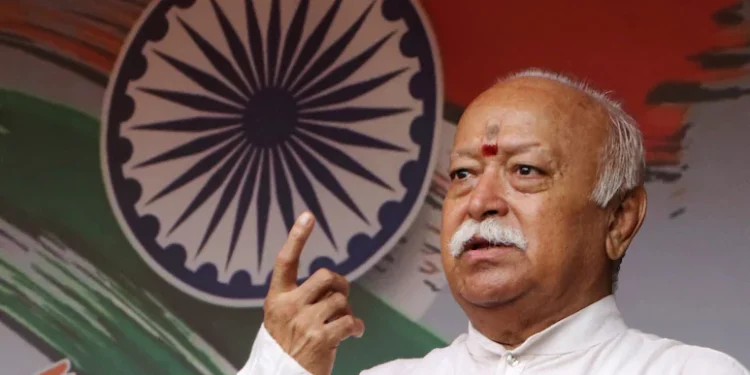In the wake of controversial comments by RSS chief Mohan Bhagwat, questioning the completeness of India’s independence in 1947, the political and historical debate has once again taken center stage. Bhagwat suggested that India only gained full sovereignty with the abrogation of Article 370 in Jammu and Kashmir and other recent political developments under the current ruling regime. Rahul Gandhi, former President of the Congress, was quick to condemn this assertion, calling it an “act of treason.” His sharp criticism underlines a deeper ideological rift in how India’s history, particularly its independence, should be understood.
Yet, this debate opens up another question: if India’s independence is still considered incomplete, then the foundation of the current political transformation—including the rise of symbols like the Ram Mandir—would not have been possible.
The Roots of India’s Independence: More than Just 1947
The traditional narrative of India’s independence is that the country became free from British colonial rule in 1947, following years of struggle and sacrifice. Leaders like Mahatma Gandhi, Jawaharlal Nehru, and Sardar Patel led the charge for a unified, democratic India. However, Bhagwat’s comment challenges this narrative, suggesting that true freedom was only realized after recent political developments—such as the revocation of Article 370, which gave special status to Jammu and Kashmir. This assertion has led to a controversial rethinking of India’s independence, particularly regarding the ideological and political milestones that have defined the nation in recent years.
But if we are to follow Bhagwat’s line of thinking, and assert that India’s independence only took shape in recent years, it raises another crucial point: The emergence of the Ram Mandir movement and the eventual construction of the Ram Mandir in Ayodhya would not have been possible without the shifts in political power that followed India’s post-independence evolution.
The Ram Mandir: Symbolizing India’s Changing Identity
The Ram Mandir movement in Ayodhya, a long-standing political and cultural project, symbolizes the intersection of religion, nationalism, and the state in contemporary India. For decades, the demand for a Ram temple at the disputed site in Ayodhya was a focal point of political discourse, especially for Hindu nationalist groups like the RSS and its affiliates. The construction of the Ram Mandir, now underway, represents the culmination of decades of political struggle, and has been promoted as a symbol of India’s Hindu identity.
This movement, however, would have been unthinkable without the transformation of India’s political landscape in the years after its independence. It was only after the rise of the BJP and the RSS in national politics, culminating in the 1990s and beyond, that the Ram Mandir movement gained the momentum it needed. The growing influence of Hindu nationalist ideology gradually reshaped the narrative of India’s national identity, moving away from a secular, pluralistic vision toward one focused on Hindu cultural supremacy.
The Ram Mandir issue was pivotal in galvanizing support for the BJP in the 1990s, with the Babri Masjid demolition in 1992 serving as a watershed moment in the political and religious upheaval that followed. If we are to take Bhagwat’s view that India’s independence was incomplete until recent years, the Ram Mandir’s eventual construction represents the fulfillment of a political and cultural promise that could only come to fruition once India had fully embraced its Hindu identity.
Independence and Identity: A Complex Relationship
The question of India’s independence and its transformation into a Hindu-centric state has long been a point of contention. For many, including Congress and other secular groups, the idea of a pluralistic India that celebrates its diversity is non-negotiable. However, for the RSS and its affiliates, India’s true freedom lies in its cultural roots, which they define through a Hindu lens.
The Ram Mandir, as a symbol, is much more than a religious site. It is a cultural and political marker of how far India has come in reclaiming its supposed “Hindu identity.” In this context, independence becomes not just a political event but a broader, ongoing struggle to establish the identity that the state should embrace.
Without the shift in political power after the Congress era, which laid the groundwork for the rise of Hindu nationalism, the Ram Mandir would not have gained the traction it did. The movement is a direct reflection of the cultural and political assertions made by Hindu nationalist groups, particularly the RSS, who view the temple as the restoration of India’s cultural integrity. The importance of this temple is symbolic of a broader struggle to redefine India’s identity post-independence.
A Political Debate with Deeper Consequences
The political ramifications of these ideological divides are enormous. Rahul Gandhi’s condemnation of Bhagwat’s remarks is not merely about defending the legacy of the Indian freedom struggle; it is about protecting the vision of India as a secular, inclusive nation. The Congress and other opposition groups argue that a diverse and pluralistic India—where all religions are respected—is the very foundation of its independence, achieved in 1947.
In contrast, the RSS and the BJP have worked to redefine India through the lens of Hindu nationalism, drawing on symbols like the Ram Mandir to promote a vision of India that emphasizes its Hindu heritage above all else. This reinterpretation of India’s independence is not just about politics—it’s about identity and culture.
Conclusion: Independence as a Continuing Struggle
If we are to accept Bhagwat’s claim that India’s independence was incomplete until recent years, then the emergence of the Ram Mandir as a symbol of national identity becomes the ultimate fulfillment of that independence. But this raises a critical question: what kind of India are we building, and whose vision of freedom are we embracing?
The legacy of India’s freedom struggle, while rooted in the sacrifices made by millions for political autonomy, must also contend with the political battles that continue to shape the country today. The Ram Mandir, in this context, represents both the culmination of a long-standing cultural struggle and the deep divisions that continue to define India’s post-independence journey.
Thus, India’s independence is not a fixed event but an ongoing process, and as the nation confronts its present-day identity crisis, the question remains: What does freedom truly mean in a country that is still navigating its ideological, political, and cultural evolution? The construction of the Ram Mandir, and the political forces behind it, provide a glimpse of the future India—one shaped by nationalism, religion, and identity. Whether this vision of independence is one that all Indians can embrace is a question that will shape the country’s future for generations to come.













